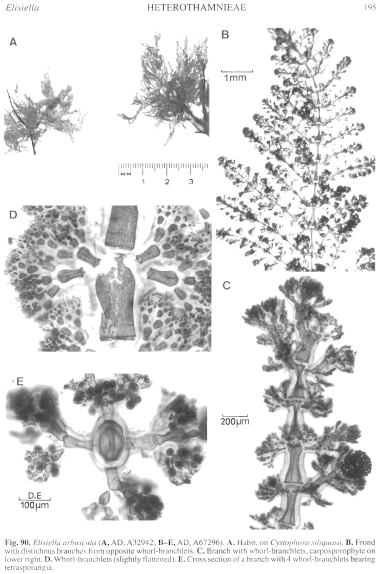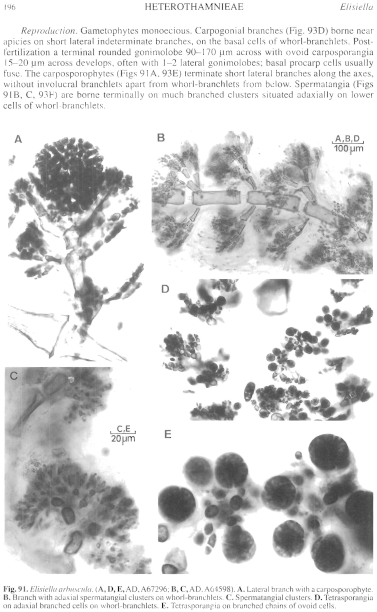|
|
|
|
|
|||||||||||
|
Electronic Flora of South Australia Species Fact Sheet
Phylum Rhodophyta – Order Ceramiales – Family Ceramiaceae – Tribe Heterothamnieae
Synonyms
Perithamnion arbuscula J. Agardh 1892: 31.
Tetrathamnion arbuscula (J. Agardh) Athanasiadis 1996: 190, fig. 99 (in part, not figs 100–102).
Perithamnion ceramioides sensu Wollaston 1968: 369, fig. 35A–C.
Perithamnion densum Wollaston 1968, 370, fig. 34A–G.
Tetrathamnion densum (Wollaston) Athanasiadis 1996: 193, fig. 103.
Thallus (Figs 90A, 93A) 2–6 cm high, somewhat complanately branched with several erect main axes bearing lateral branches more or less distichously (Fig. 90B) from lower and central parts of the thallus, few from upper parts, each axial cell with 4 similar whorl-branchlets (Fig. 90C–E) with the lateral branchlets often slightly more developed; lateral branches arising from basal cell of whorl-branchlets (Fig. 93B), especially from opposite lateral whorl-branchlets. Attachment by rhizoids from basal cells of axes, just penetrating the host cortex; epiphytic, usually on Cystophora spp. Structure. Apical cells 4–6 µm in diameter and L/D 1–1.5, enlarging rapidly to thick walled axial cells 80–130 µm in diameter and L/D 2–4 (–7) in mid axes and 150–350 µm in diameter and L/D (1–) 1.5–2 in lower axes. Whorl-branchlets (Fig. 90D, E) coarse, more or less complanately branched and slightly upwardly curved, usually closely adjacent, (180–) 200–350 µm long, branched from the basal cell with several successive subdi- (or tri-) chotomies and sometimes a terminal chain of 2–3 cells, often with a unicellular terminal hair; basal cells of whorl-branchlets 40–60 (–90) µm in diameter and L/D 1–2, tapering to rounded terminal cells 8–12 µm in diameter and L/D 1–1.5 (–2); gland cells (Fig. 93C) prominent on terminal and subterminal cells of whorl-branchlets, hemispherical to ovoid, touching only the bearing cell or abutting the next upper cell, (12–) 15–25 µm in diameter. Cells uninucleate; rhodoplasts discoid in small cells, becoming ribbon like in axial cells.
Reproduction: Gametophytes monoecious. Carpogonial branches (Fig. 93D) borne near apicies on short lateral indeterminate branches, on the basal cells of whorl-branchlets. Post-fertilization a terminal rounded gonimolobe 90–170 µm across with ovoid carposporangia 15–20 µm across develops, often with 1–2 lateral gonimolobes; basal procarp cells usually fuse. The carposporophytes (Figs 91A, 93E) terminate short lateral branches along the axes, without involucral branchlets apart from whorl-branchlets from below. Spermatangia (Figs 91B, C, 93F) are borne terminally on much branched clusters situated adaxially on lower cells of whorl-branchlets.
Tetrasporangia when first formed appear sessile but when profuse they occur on branched clusters of ovoid cells (Figs 91D, E, 93G), lying abaxially above the whorl-branchlet, subspherical, 25–50 µm in diameter, tetrahedrally divided.
Type from Port Phillip Heads, Vic. (Wilson, 26.x.1889); holotype in Herb. Agardh, LD, 18202.
Selected specimens: Sarge Bay, Cape Leeuwin, W. Aust., on Cystophora retorta, drift (Parsons, 16.xi.1968; AD, A34213). Nanerup, E of Albany, W. Aust., on Cystophora brownii, upper sublittoral (Parsons, 19.xi.1968; AD, A33982). Head of Great Australian Bight, S. Aust., on Sargassum, drift (Parsons, 4.xi.1968; AD, A34184). Cape Carnot, S. Aust., on Cystophora subfarcinata in large pool (Womersley, 3.xii.1975; AD, A46788). Pennington Bay, Kangaroo I., S. Aust., on Cystophora siliquosa, upper sublittoral (Parsons, 17.xi.1967; AD, A32056 - "Marine Algae of southern Australia" No. 104a, as P. ceramioides) and (Wollaston, 21.xi.1968; AD, A32942 - "Marine Algae of southern Australia" No. 104b, as P. ceramioides). Rosetta Bay, Victor Harbor, S. Aust., on Cystophora moniliformis, drift (Womersley, 3.xi.1997; AD, A67295) and on Carpoglossum confluens, drift (Womersley, 3.xi.1997; AD, A67296).
Distribution: Cape Leeuwin, W. Aust., to Port Phillip Heads, Victoria.
Taxonomic notes: Elisiella arbuscula is superficially similar to Perithamnion ceramioides but differs in the absence of subdichotomous apical branching and in having coarser and larger axial cells, whorl-branchlets, and the cells thereof. Male thalli also show distinct adaxial clusters of spermatangia, as in Tetrathamnion and distinct from the terminal spermatangia in Perithamnion, and tetrasporangia are sessile in P. ceramioides but (apart possibly when just forming) are on branched clusters of small ovoid cells in E. arbuscula.
P. densum Wollaston appears to be only a densely branched form of E. arbuscula.
E. arbuscula is a common species on rough-water coasts along most of southern Australia (perhaps especially on Kangaroo I.), usually epiphytic on Cystophora at or just below low tide level. Tetrathamnion lineatum, in contrast, usually occurs subtidally in calmer conditions (see under this species).
References:
AGARDH, J.G. (1892). Analecta Algologica. Acta Univ. lund. 28, 1–182, Plates 1–3.
ATHANASIADIS, A. (1996). Morphology and classification of the Ceramioideae (Rhodophyta) based on phylogenetic principles. Opera Botanica No. 128, pp. 1–216.
WOLLASTON, E.M. (1968).Morphology and taxonomy of southern Australian genera of Crouanieae Schmitz (Ceramiaceae, Rhodophyta). Aust. J. Bot. 16, 217–417.
The Marine Benthic Flora of Southern Australia Part IIIC complete list of references.
Publication:
Womersley, H.B.S. (24 December, 1998)
The Marine Benthic Flora of Southern Australia
Rhodophyta. Part IIIC. Ceramiales – Ceramiaceae, Dasyaceae
©State Herbarium of South Australia, Government of South Australia
Illustrations in Womersley Part IIIA, 1998: FIGS 90, 91, 93 A–G.

Figure 90 enlarge
Fig. 90. Elisiella arbuscula (A, AD, A32942; B–E, AD, A67296). A. Habit, on Cystophora siliquosa. B. Frond with distichous branches from opposite whorl-branchlets. C. Branch with whorl-branchlets, carposporophyte on lower right. D. Whorl-branchlets (slightly flattened). E. Cross section of a branch with 4 whorl-branchlets bearing tetrasporangia.

Figure 91 enlarge
Fig. 91. Elisiella arbuscula. (A, D, E, AD, A67296; B, C, AD, A64598). A. Lateral branch with a carposporophyte. B. Branch with adaxial spermatangial clusters on whorl-branchlets. C. Spermatangial clusters. D. Tetrasporangia on adaxial branched cells on whorl-branchlets. E. Tetrasporangia on branched chains of ovoid cells.

Figure 93 enlarge
Fig. 93.A–G. Elisiella arbuscula (AD, A27009) A. Habit. B. One of 4 whorl-branchlets with gland cells and a young lateral on the basal cell. C. Gland cell on outer cells of a whorl-branchlet. D. Carpogonial branch (on right) and just post-fertilization stage (on left) near axial apex. E. A carposporophyte. F. A spermatangial cluster on a lower cell of a whorl-branchlet. G. Tetrasporangia on a special adaxial branch on basal cell of a whorl-branchlet. H–N. Elisiella dispar (AD, uncertain). H. Habit, with a prostrate axis bearing erect axes. I. Attachment rhizoids arising from the basal cell of a whorl-branchlet. J. A whorl-branchlet bearing gland cells. K. Part of a whorl-branchlet with a gland cell. L. Carpogonial branch on basal cell of a 2-celled branchlet. M. A mature carposporophyte. N. Tetrasporangia borne on special branches of short cells. O–U. Tetrathamnion lineatum (O–T, AD, A27686). O. Habit. P. Axial apex with young whorl-branchlets with gland cells. Q. Attachment rhizoids from basal axial cells. R. Axial apex with carpogonial branches on basal cells of whorl-branchlets. S. Mature carposporophyte with young gonimolobes. T. Whorl-branchlet with tetrasporangia. U. Habit of densely branched form (T. ramosum). (All as in Wollaston 1968, courtesy of Aust. J. Bot.)

|
Email Contact: State Herbarium of South Australia |

|